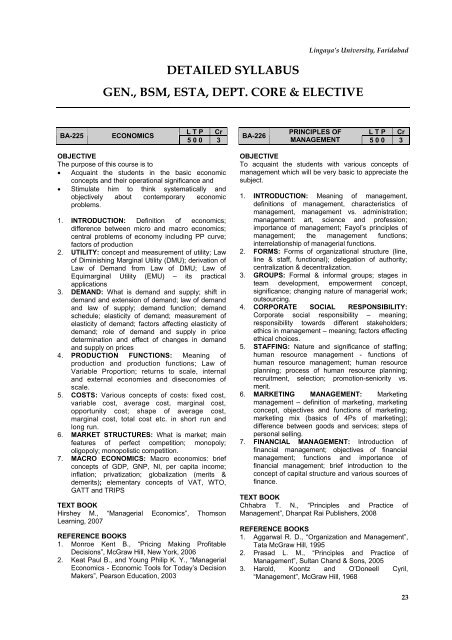B.Tech. Degree Programme Computer Science & Engineering
B.Tech. Degree Programme Computer Science & Engineering
B.Tech. Degree Programme Computer Science & Engineering
Create successful ePaper yourself
Turn your PDF publications into a flip-book with our unique Google optimized e-Paper software.
Lingaya’s University, FaridabadDETAILED SYLLABUSGEN., BSM, ESTA, DEPT. CORE & ELECTIVEBA-225ECONOMICSL T P Cr5 0 0 3BA-226PRINCIPLES OF L T P CrMANAGEMENT 5 0 0 3OBJECTIVEThe purpose of this course is to• Acquaint the students in the basic economicconcepts and their operational significance and• Stimulate him to think systematically andobjectively about contemporary economicproblems.1. INTRODUCTION: Definition of economics;difference between micro and macro economics;central problems of economy including PP curve;factors of production2. UTILITY: concept and measurement of utility; Lawof Diminishing Marginal Utility (DMU); derivation ofLaw of Demand from Law of DMU; Law ofEquimarginal Utility (EMU) – its practicalapplications3. DEMAND: What is demand and supply; shift indemand and extension of demand; law of demandand law of supply; demand function; demandschedule; elasticity of demand; measurement ofelasticity of demand; factors affecting elasticity ofdemand; role of demand and supply in pricedetermination and effect of changes in demandand supply on prices4. PRODUCTION FUNCTIONS: Meaning ofproduction and production functions; Law ofVariable Proportion; returns to scale, internaland external economies and diseconomies ofscale.5. COSTS: Various concepts of costs: fixed cost,variable cost, average cost, marginal cost,opportunity cost; shape of average cost,marginal cost, total cost etc. in short run andlong run.6. MARKET STRUCTURES: What is market; mainfeatures of perfect competition; monopoly;oligopoly; monopolistic competition.7. MACRO ECONOMICS: Macro economics: briefconcepts of GDP, GNP, NI, per capita income;inflation; privatization; globalization (merits &demerits); elementary concepts of VAT, WTO,GATT and TRIPSTEXT BOOKHirshey M., “Managerial Economics”, ThomsonLearning, 2007REFERENCE BOOKS1. Monroe Kent B., “Pricing Making ProfitableDecisions”, McGraw Hill, New York, 20062. Keat Paul B., and Young Philip K. Y., “ManagerialEconomics - Economic Tools for Today’s DecisionMakers”, Pearson Education, 2003OBJECTIVETo acquaint the students with various concepts ofmanagement which will be very basic to appreciate thesubject.1. INTRODUCTION: Meaning of management,definitions of management, characteristics ofmanagement, management vs. administration;management: art, science and profession;importance of management; Fayol’s principles ofmanagement; the management functions;interrelationship of managerial functions.2. FORMS: Forms of organizational structure (line,line & staff, functional); delegation of authority;centralization & decentralization.3. GROUPS: Formal & informal groups; stages inteam development, empowerment concept,significance; changing nature of managerial work;outsourcing.4. CORPORATE SOCIAL RESPONSIBILITY:Corporate social responsibility – meaning;responsibility towards different stakeholders;ethics in management – meaning; factors effectingethical choices.5. STAFFING: Nature and significance of staffing;human resource management - functions ofhuman resource management; human resourceplanning; process of human resource planning;recruitment, selection; promotion-seniority vs.merit.6. MARKETING MANAGEMENT: Marketingmanagement – definition of marketing, marketingconcept, objectives and functions of marketing;marketing mix (basics of 4Ps of marketing);difference between goods and services; steps ofpersonal selling.7. FINANCIAL MANAGEMENT: Introduction offinancial management; objectives of financialmanagement; functions and importance offinancial management; brief introduction to theconcept of capital structure and various sources offinance.TEXT BOOKChhabra T. N., “Principles and Practice ofManagement”, Dhanpat Rai Publishers, 2008REFERENCE BOOKS1. Aggarwal R. D., “Organization and Management”,Tata McGraw Hill, 19952. Prasad L. M., “Principles and Practice ofManagement”, Sultan Chand & Sons, 20053. Harold, Koontz and O’Doneell Cyril,“Management”, McGraw Hill, 196823
















